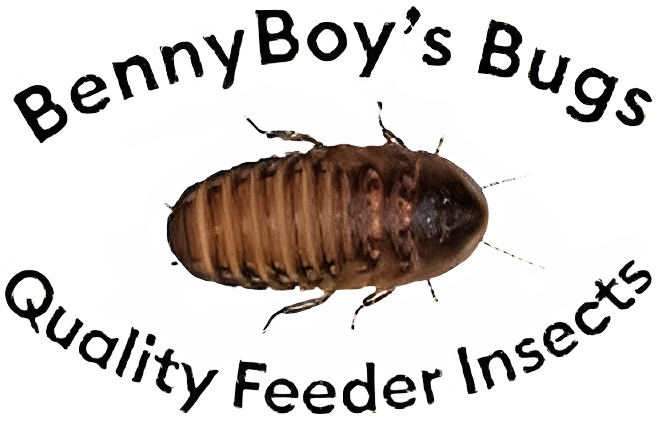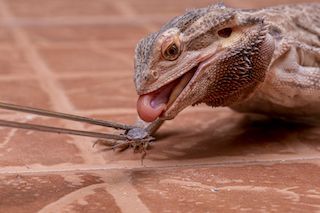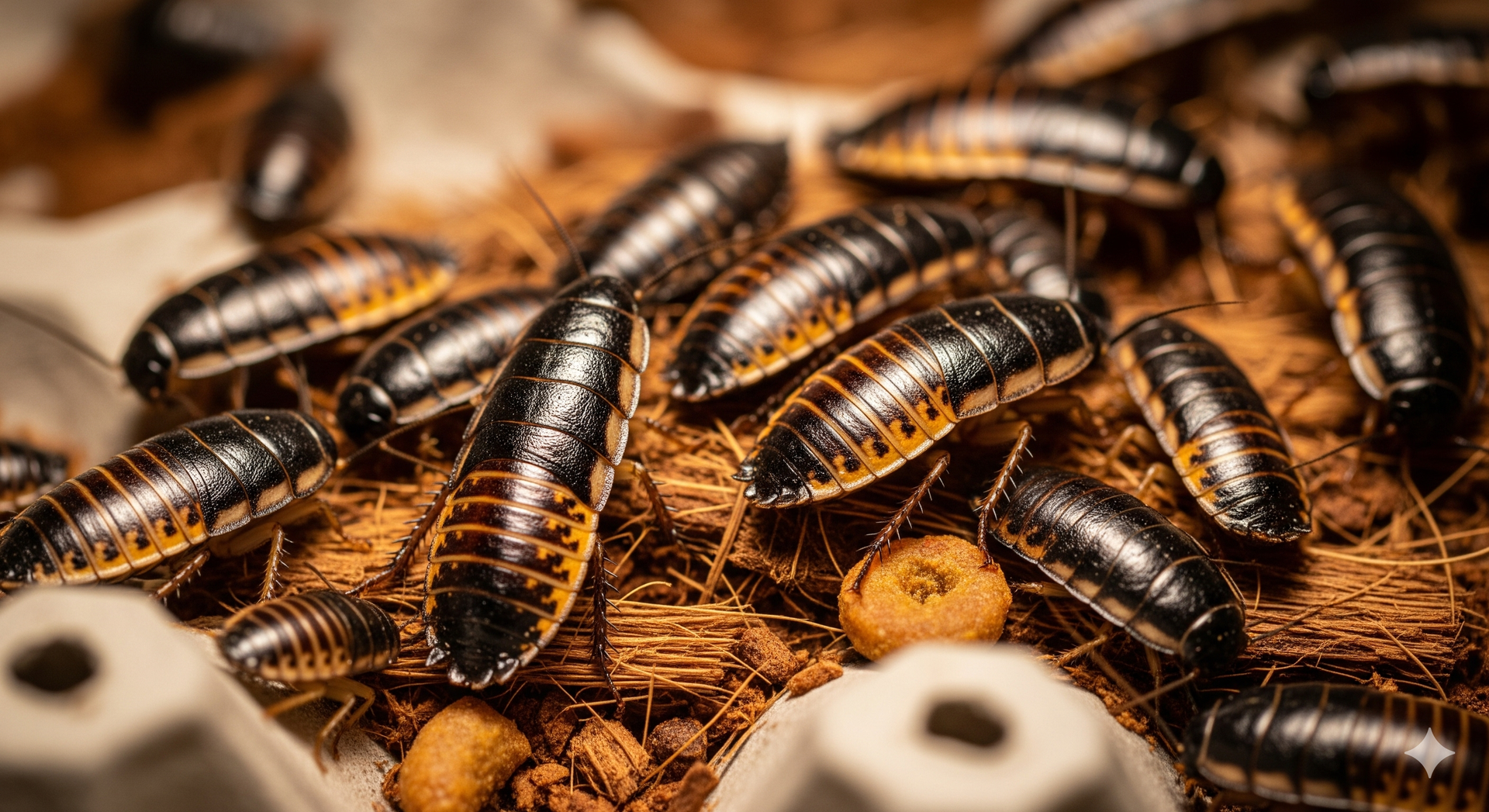Reptile Feeding Guide: How Many Dubia Roaches Does Your Pet Need?
Providing the right amount of nutrition is essential for keeping your reptile healthy and thriving. Dubia roach feeders have become increasingly popular among reptile owners because they offer excellent nutritional value, are easy to digest, and provide a clean feeding option compared to other feeder insects for sale. These versatile roach feeders contain high protein levels, essential amino acids, and optimal calcium-to-phosphorus ratios that support proper bone development and muscle maintenance. Understanding proper portion sizes and feeding frequencies helps ensure your scaly companion receives optimal nutrition without overfeeding or underfeeding.
Whether you're caring for a bearded dragon, leopard gecko, or monitor lizard, determining the correct number of roaches for reptiles requires considering factors like species, age, size, and activity level. Unlike traditional cricket feeding, dubia roaches offer superior nutritional density with longer shelf life and reduced odor concerns. This comprehensive guide will help you establish appropriate feeding schedules and portion sizes to support your pet's long-term health and well-being while maximizing the benefits of this premium reptile food choice.
Key Takeaways
- Adult reptiles typically need 3-6 appropriately sized dubia roach feeders per feeding session
- Juvenile reptiles require daily feeding, while adults can be fed every other day or twice weekly
- Roach size should be no wider than the space between your reptile's eyes
- Monitor your pet's body condition and adjust feeding amounts based on weight and activity levels
- Pregnant or breeding females need increased feeding frequency and portion sizes
- Quality reptile food includes properly gut-loaded feeder insects from reputable sources
Understanding Your Reptile's Nutritional Needs
Different reptile species have varying dietary requirements that influence how many dubia roach feeders they need. Laboratory-tested dubia roaches contain approximately 21-23% protein content, providing essential amino acids that support tissue repair and growth processes.
Key factors that determine nutritional needs include:
- Species type - Insectivorous species like bearded dragons rely heavily on live bugs for sale as their primary protein source
- Age and development stage - Growing juveniles require more frequent meals with higher protein content to support rapid development
- Body size correlation - Larger species need substantially more food, though metabolic rates vary between species
- Environmental conditions - Proper temperature gradients and lighting cycles maintain healthier appetites and predictable feeding patterns
The digestibility of dubia roach feeders makes them particularly suitable for younger animals whose digestive systems are still developing. Seasonal changes, breeding cycles, and brumation periods can temporarily alter normal feeding behaviors and requirements.
Factors That Determine Feeding Amounts
Several important considerations determine how much reptile food your pet requires. The general rule for roach feeder sizing states that individual insects should be no wider than the space between your reptile's eyes.
Primary feeding factors include:
- Species-specific patterns - Bearded dragons typically consume 3-5 appropriately sized dubia roach feeders per meal as adults
- Life stage requirements - Breeding females require increased nutrition to support egg production
- Environmental factors - Proper temperature gradients enable efficient metabolism and feeding response
- Health considerations - Reptiles recovering from illness often need modified feeding schedules with easily digestible options
Smaller roaches may be offered in higher quantities, while larger roaches require reduced numbers to maintain appropriate total food volume. Stress from inappropriate lighting, overcrowding, or frequent handling can also suppress normal eating behaviors and affect portion requirements.
Feeding Schedule Guidelines
Establishing consistent feeding schedules benefits both reptile health and owner convenience. Juvenile reptiles under one year typically require daily feeding sessions to support rapid growth rates. These young animals should receive appropriately sized portions every 24 hours, preferably during their most active periods when natural feeding behaviors peak.
Adult reptiles generally thrive with feeding every other day or twice weekly, depending on species and individual metabolism. This schedule allows complete digestion between meals while maintaining steady nutrition intake. Some larger species may accept weekly feeding schedules, particularly during cooler months when metabolic rates naturally decrease.
Timing feeding sessions during natural activity periods improves feeding responses and digestion efficiency. Most reptiles show increased appetite during morning hours after basking temperatures reach optimal levels. Evening feeding can work for nocturnal species, but avoid feeding too close to lights-out when temperatures begin dropping for the night cycle.
Monitoring feeding responses helps fine-tune schedules for individual animals. Healthy reptiles should show interest in food within reasonable timeframes and consume offered portions completely. Consistent refusal of food may indicate health issues, environmental problems, or simply that feeding frequency exceeds the animal's needs.
Age-Based Feeding Recommendations
Different life stages require specific feeding approaches to support optimal health and development. The following guidelines provide general recommendations that should be adjusted based on individual animal responses and species-specific requirements.
| Age Group | Frequency | Quantity | Notes |
|---|---|---|---|
| Juveniles (0-6 months) | Daily | 2-4 small roaches | High protein needs for growth |
| Sub-adults (6-12 months) | Every other day | 3-5 medium roaches | Transitioning to adult schedule |
| Adults (1+ years) | 2-3 times weekly | 4-6 large roaches | Maintenance feeding |
| Breeding females | Daily | 5-8 large roaches | Increased needs during reproduction |
These recommendations serve as starting points that should be adjusted based on individual animal responses. Some reptiles may require slightly more or less food depending on their metabolism, activity level, and overall health status. Regular monitoring helps determine if adjustments are needed.
Nutritional Benefits and Quality Indicators
Quality dubia roach feeders offer superior nutritional advantages compared to many traditional feeder insects for sale. Independent laboratory testing shows their protein content ranges from 21-23%, providing essential amino acids necessary for muscle development and metabolic functions.
Key nutritional advantages include:
- Digestibility benefits - Softer exoskeleton compared to crickets reduces impaction risk while providing beneficial fiber
- Moisture content support - Helps maintain hydration, particularly important for desert species
- Improved ratios - Research demonstrates that properly gut-loaded roaches can achieve better calcium-to-phosphorus ratios
Quality indicators for healthy roaches for reptiles:
- Active movement patterns and appropriate environmental responses
- Well-rounded appearance free from visible damage or discoloration
Research indicates that feeding roaches high-quality vegetables, fruits, and commercial gut-loading products for at least 24 hours before offering them to your reptile provides optimal nutritional enhancement. Popular gut-loading foods include leafy greens, carrots, sweet potatoes, and specialized commercial preparations designed for calcium enhancement.
Monitoring Your Reptile's Body Condition
You should regularly assess the body condition of your reptiles to ensure that your feeding schedule provides appropriate nutrition without overfeeding. Healthy reptiles should maintain a consistent weight with visible muscle tone and appropriate fat reserves. Learning to recognize optimal body condition for your specific species allows you to proactively adjust their feeding protocols. Weekly weight monitoring using digital scales provides objective data to complement visual assessments.
Visual indicators of good body condition include alert behavior, strong feeding responses, and normal activity patterns. The animal should feel firm but not bony when gently handled, with no visible ribs or hip bones protruding. Tail bases should appear rounded rather than pinched, and limbs should show good muscle definition without excess fat deposits. Healthy reptiles typically show consistent growth patterns during juvenile stages and stable weight maintenance as adults.
Signs of underfeeding include lethargy, weak feeding responses, visible bone structure, and decreased activity levels. These animals may also show increased aggression during feeding time or attempt to consume inappropriate substrate materials. Gradual weight loss over time indicates the need to increase feeding frequency or portion sizes. Sunken eyes, wrinkled skin, and reduced alertness may signal more serious nutritional deficiencies requiring immediate attention.
Overfeeding symptoms include excessive weight gain, reduced mobility, and fatty deposits around the neck or limb joints. Obese reptiles may show decreased interest in food or difficulty moving normally. These conditions can lead to serious health complications and require immediate dietary adjustments with veterinary guidance. Proper portion control with quality dubia roach feeders helps prevent obesity while ensuring adequate nutrition.
Special Considerations and Adjustments
Seasonal variations naturally affect reptile appetites and feeding requirements. Many species reduce food intake during cooler months, even in controlled indoor environments. This normal behavior may require temporary adjustments to feeding schedules and portions to prevent food spoilage and maintain appropriate body condition.
Breeding seasons typically increase nutritional demands, particularly for female reptiles preparing for egg production. These animals may require daily feeding sessions with larger portions to support reproductive processes. Males may also show increased appetite during breeding periods, though some species actually reduce food intake while focused on territorial behaviors.
Health considerations sometimes necessitate modified feeding approaches. Recovering animals may benefit from smaller, more frequent meals using easily digestible feeder insects for sale. Elderly reptiles might require softer food options or extended feeding times to accommodate slower reflexes and reduced jaw strength.
Environmental stressors can significantly impact feeding behaviors and nutritional needs. Recent relocations, enclosure modifications, or changes in household routines may temporarily suppress appetites. Providing consistent conditions and minimizing disturbances during feeding times helps maintain normal eating patterns.
Frequently Asked Questions
How do I know if my dubia roach feeders are the right size?
The roach should be no wider than the space between your reptile's eyes when measured from the widest point of the insect's body. This sizing rule helps prevent choking and ensures proper digestion for optimal health.
Can I feed my reptile only dubia roaches?
While dubia roaches provide excellent nutrition, most reptiles benefit from dietary variety, including different feeder insects for sale and appropriate vegetation. Rotating between various live bugs for sale helps ensure balanced nutrition and prevents dietary boredom.
What should I do if my reptile refuses to eat dubia roaches?
Try offering roaches at different times of day or varying the size of the insects. Some reptiles prefer movement, so using feeding tongs to simulate prey behavior can increase interest in this reptile food option.
How long can I store live dubia roaches?
Live dubia roaches can survive several weeks when properly housed with appropriate temperature, humidity, and food sources. Proper storage maintains their nutritional value and ensures healthy roach feeders for your reptile.
Should I gut-load my dubia roaches before feeding?
Gut-loading roaches 24-48 hours before feeding significantly improves their nutritional value for your reptile. Feed the roaches high-quality vegetables and commercial gut-loading products to maximize the benefit of this reptile food source.
Final Thoughts
Proper feeding with dubia roach feeders supports your reptile's long-term health and well-being when implemented thoughtfully. Understanding your pet's specific needs, monitoring body condition regularly, and adjusting portions based on individual responses creates a sustainable feeding program that promotes optimal nutrition. The superior nutritional profile of quality roaches for reptiles makes them an excellent investment in your pet's health and longevity.
Remember that these guidelines provide starting points that should be customized for your individual animal. Regular observation, consistent record-keeping, and consultation with reptile veterinarians when needed help ensure your feeding program continues supporting your pet's health throughout their lifetime. Quality roaches for reptiles, combined with appropriate feeding schedules, create the foundation for successful reptile care. Whether you're maintaining a single pet or managing multiple animals, establishing proper feeding protocols with reliable feeder insects for sale ensures consistent nutrition and reduces long-term health complications.
Ready to feed your reptile right? Shop premium dubia roach feeders for sale - delivered fresh to your door.
Reference:
https://www.petmd.com/reptile/conditions/how-tell-if-your-lizard-sick


